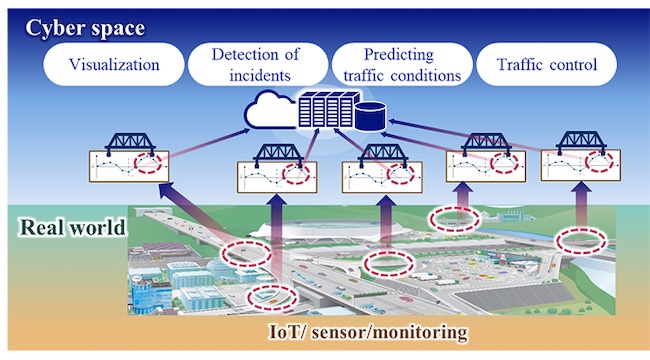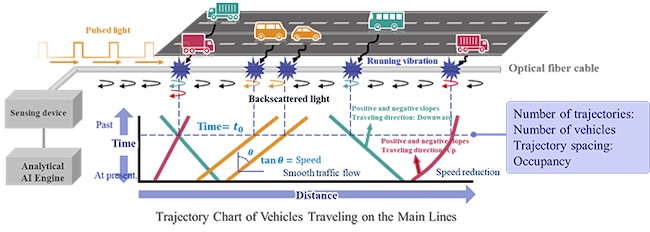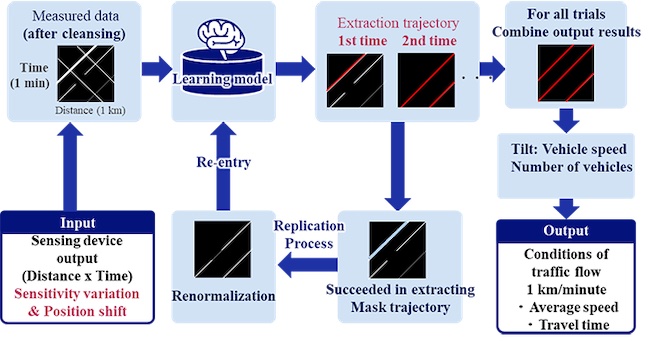
TOKYO, May 24, 2022 – (JCN Newswire via SEAPRWire.com) – NEC Corporation has deployed an AI-based traffic monitoring system to Central Nippon Expressway Company Limited (NEXCO CENTRAL). The system uses fiber-optic sensing and AI technologies to visualize traffic conditions, such as the location, speed, and direction of travel, from vibrations produced by vehicle movement.
 |
 |
 |
 |
The system includes sensing devices attached to one end of an optical fiber and an analytical AI engine, developed in-house by NEC, which makes it possible to continuously monitor traffic flow by utilizing existing optical fiber infrastructure for communications laid along highways. NEXCO is the first expressway operator in Japan to continuously monitor traffic conditions using these kinds of technologies.
Highway operators need to monitor traffic flow and to detect incidents on expressways for traffic control. Most sensors in use today for this purpose are point sensors or cameras with a limited field of view. A large number of point sensors and/or cameras are needed to perform continuous measurements over a wide area, which poses problems for installation and maintenance, leading to higher system costs.
NEC has a successful history of conducting joint demonstration projects using optical fiber sensing technology for detecting cracks in poles and monitoring road traffic (*). Based on these experiences and knowledge, NEC is providing equipment to convert optical fiber cables to sensors.
NEC has now developed an analytical AI engine that continuously grasps traffic conditions based on the signals from vehicle vibrations. The system can visualize dense traffic conditions with a high level of accuracy. The AI engine converts vibration data into continuous vehicle trajectories along roads that are entirely monitored. The trajectories can then be used to estimate average speeds every kilometer. The system can record a digital snapshot of traffic conditions over a wide area, which can enhance road controls with continuous monitoring of entire roadways, enabling early detection of accidents and congestion.
The newly developed analytical AI engine can extract vehicle trajectories from vibration signals in the presence of multiple environmental noises. Vehicle trajectories are extracted in an iterative process. First, the clearest vibration signals are used to extract vehicle trajectory, then the corresponding signals are masked. Second, the remaining vibration signals are enhanced. The system repeats these two steps until all the vehicle trajectories are extracted.
The AI engine has been trained with synthetic data, including realistic environmental noise, enabling robust extraction of vehicle trajectories in the presence of noise. Then, the system can monitor high-density traffic flow over a wide area with high accuracy.
Going forward, NEC will continue to support the digital transformation (DX) of road operators as part of achieving the “NEC Safer Cities” initiative for contributing to the creation of safer and more secure cities.
For More Information
Optical Fiber Sensing:
https://www.nec.com/en/global/solutions/ofs/
(*) Verizon and NEC just made fiber sensing a whole lot easier
https://www.nec.com/en/press/201910/global_20191008_02.html
About NEC Corporation
NEC Corporation has established itself as a leader in the integration of IT and network technologies while promoting the brand statement of “Orchestrating a brighter world.” NEC enables businesses and communities to adapt to rapid changes taking place in both society and the market as it provides for the social values of safety, security, fairness and efficiency to promote a more sustainable world where everyone has the chance to reach their full potential. For more information, visit NEC at https://www.nec.com.
Copyright 2022 JCN Newswire. All rights reserved. (via SEAPRWire)


